 |
||
|
||
| ||
 Today we continue examination of production video cards based on the NVIDIA Titanium. NVIDIA GeForce3 Ti 500 and ATI RADEON 8500 based cards are the most powerful accelerators today. The former is a bit quicker but NVIDIA doesn't have such a confident leadership as it recently had. We'll see for how long ATI will be able to keep up with its competitor. We already studied several NVIDIA GeForce3 Ti 500 based cards, and the whole theoretical base connected with the GeForce3 is concentrated in the following articles:
Today the GeForce3 Ti 500 is the most powerful 3D accelerator of the gaming class (but in some tests the ATI RADEON 8500 catches up with it). The GeForce3 Ti 500 works at 240/250 (500) MHz. All details on speed characteristics of Ti 500 based cards can be found in our 3Digest and in the above articles. And now we are moving to one more sample on this chipset - ABIT Siluro GF3 Ti500. CardThe ABIT Siluro GF3 Ti 500 has an AGP x2/x4 interface, 64 MB DDR SDRAM located in 8 chips on the right side of the PCB.

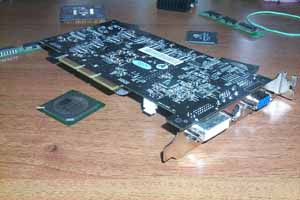 The card has memory modules from ESMT (EliteMT) with a 3.8 ns access time which corresponds to 263 (526) MHz. (And the memory operates at 250 (500) MHz.) In the Titanium series review and the following articles we showed that video cards based on the Ti 200/500 and those on the ordinary GeForce3 differ in design. It is done to make operation of the cards more stable as the memory works at a very high frequency - 250 (500) MHz. But not all Ti 500 video cards are based on the reference design. Let's compare the ABIT Siluro GF3 Ti500 and the NVIDIA's reference card: ABIT Siluro GF3 Ti 500
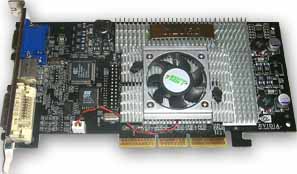
 NVIDIA GeForce3 Ti 500 reference card
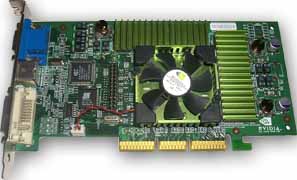
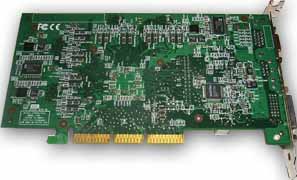 As you can see, the design is identical to the reference one. And we can be sure in stable and reliable operation of the card. The PCB has dark brown textolite and a silvery cooler:
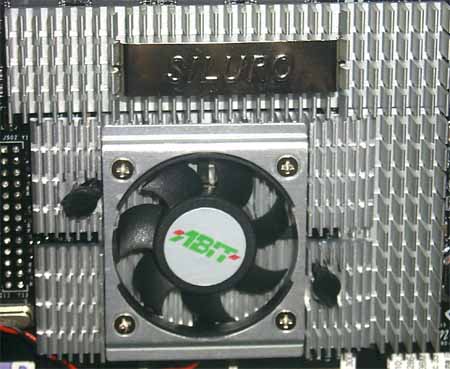 A cooler's construction is quite effective. The upper heatsink of the memory is made longer, it covers one memory chip of the vertical row, and the side heatsink is made shorter. The heatsinks stuck to the memory modules and the central heatsink are not actually connected:
 The central cooler has an intriguing design: pins are getting smaller as they move away from the center. It doesn't affect cooling ability of the device but makes it looking more interesting. But if you are going to overclock your card you should provide additional cooling:
 The ABIT Siluro GF3 Ti500 card is equipped both with TV-out and DVI.
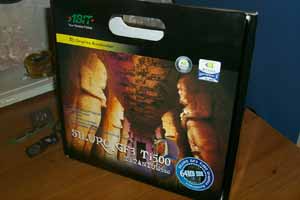 The card ships in a Retail package with the "Certified NVIDIA vendor" mark on. Accessories:
OverclockingThe ABIT Siluro GF3 Ti 500 (DVI) showed a record level in frequency growth " 270/300 (600) MHz. At the same time, the card costs $310-320 which is less than the ASUS V8200T5 that is why this card turns out to be the most optimal among Ti 500 models. Note:
Installation and driversTest system:
In the tests we used NVIDIA drivers of v.21.85. VSync was off, S3TC was on. For the comparative analyses we used the following cards:
Test results2D quality is excellent. I tried to replace the card with the RADEON 8500 but no difference could be noticed. The operation was flawless even in 1600x1200 at 85 Hz. But bear in mind that 2D quality much depends on a sample of the card and on its friendliness towards a monitor. For estimation of 3D quality we used:
Quake3 ArenaQuaver, High Quality ModesThe test was carried out in 32-bit color mode at the highest detailing level and with complicated geometry (r_subdivisions "1" r_lodCurveError "30000"). This benchmark loads an accelerator with geometry, large textures and huge effects.
 The test reveals that the ABIT Siluro GF3 Ti 500 easily beats the ATI RADEON 8500 and is identical to the NVIDIA GeForce3 Ti 500 reference card in performance. As we expected the overclocking boosts up the performance greatly. Return to Castle Wolfenstein (Multiplayer)Checkpoint, High Quality ModesThe tests were carried out in 32-bit color mode at the highest detailing and quality level of textures.
 This quite complicated test shows that the Ti 500 is not an unquestioned leader as it goes on a par with the ATI RADEON 8500 in 1600x1200. In other respects the ABIT performs similar to the GeForce3 Ti 500 reference card.
 We examined anisotropic filtering in the OpenGL of the GeForce3 cards lots of times and every time the performance drop was rather considerable, especially at Level 4 and 8. Anti-aliasing is not free as well, though every gamer dreams of playing with these two functions enabled. So, let's take a look at playability by the example of the Return to Castle Wolfenstein (Single player mode) with both functions enabled on the overclocked ABIT Siluro GF3 Ti500 card. Well, the performance falls down considerably. Taking into account that 35 fps is enough for this game, 1024x768 provides decent playability even at the highest anisotropic level and at the 4x degree of anti-aliasing. It means that the Ti 500 video cards can provide an acceptable speed with high quality and these two functions enabled. You only have to find the compromise between an AA degree and an anisotropic level. Though with such excellent overclocking results all these functions work at their highest level without damaging the quality! In closing, I'd like to advise you to read also other reviews of GeForce3 based video cards. Besides, in our 3Digest you can get thorough information on performance of these cards on different platforms. ConclusionThe card we examined today is one of the best among GeForce3 Ti 500 models in respect to an overclocking potential. However, a set of accessories is quite scanty. Although the Abit's card is a little cheaper than the MSI GF3TI500-ProVTG, it doesn't have such a rich set of accessories including VIVO. Nevertheless, if you don't need these additional functions but just a stable reference-based card the ABIT Siluro GF3 Ti500 will be an excellent choice.
The complete characteristics of video cards of this and other classes can be found in our 3Digest. Highs:
Lows:
Write a comment below. No registration needed!
|
Platform · Video · Multimedia · Mobile · Other || About us & Privacy policy · Twitter · Facebook Copyright © Byrds Research & Publishing, Ltd., 1997–2011. All rights reserved. |